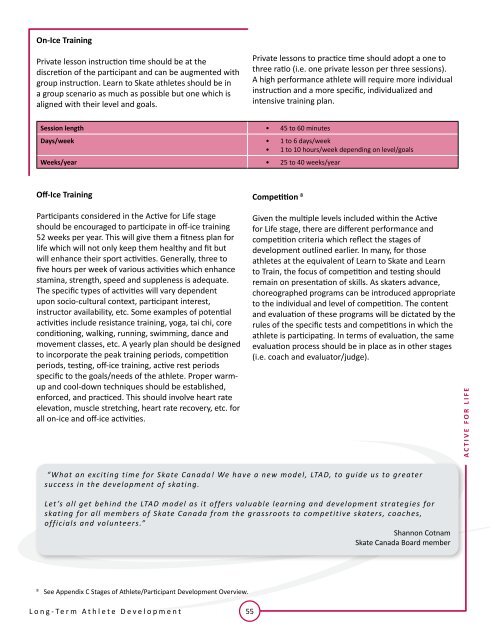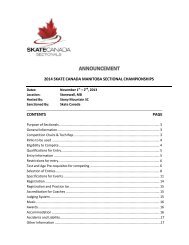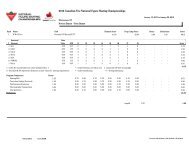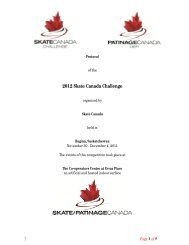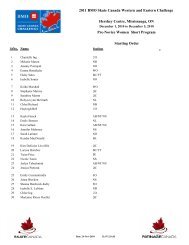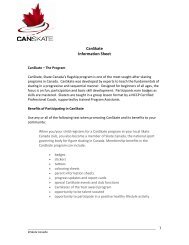LONG-TERM ATHLETE DEVELOPMENT - Skate Canada
LONG-TERM ATHLETE DEVELOPMENT - Skate Canada
LONG-TERM ATHLETE DEVELOPMENT - Skate Canada
Create successful ePaper yourself
Turn your PDF publications into a flip-book with our unique Google optimized e-Paper software.
On-Ice Training<br />
Private lesson instruction time should be at the<br />
discretion of the participant and can be augmented with<br />
group instruction. Learn to <strong>Skate</strong> athletes should be in<br />
a group scenario as much as possible but one which is<br />
aligned with their level and goals.<br />
L o n g - Te r m A t h l e t e D e v e l o p m e n t<br />
Phone 613.747.1007 I Toll Free 1.888.747.2372 I Fax 613.748.5718 I Toll Free Fax 1.877.211.2372<br />
Session length • 45 to 60 minutes<br />
Days/week • 1 to 6 days/week<br />
• 1 to 10 hours/week depending on level/goals<br />
Weeks/year • 25 to 40 weeks/year<br />
Off-Ice Training<br />
Participants considered in the Active for Life stage<br />
should be encouraged to participate in off-ice training<br />
52 weeks per year. This will give them a fitness plan for<br />
life which will not only keep them healthy and fit but<br />
will enhance their sport activities. Generally, three to<br />
five hours per week of various activities which enhance<br />
stamina, strength, speed and suppleness is adequate.<br />
The specific types of activities will vary dependent<br />
upon socio-cultural context, participant interest,<br />
instructor availability, etc. Some examples of potential<br />
activities include resistance training, yoga, tai chi, core<br />
conditioning, walking, running, swimming, dance and<br />
movement classes, etc. A yearly plan should be designed<br />
to incorporate the peak training periods, competition<br />
periods, testing, off-ice training, active rest periods<br />
specific to the goals/needs of the athlete. Proper warmup<br />
and cool-down techniques should be established,<br />
enforced, and practiced. This should involve heart rate<br />
elevation, muscle stretching, heart rate recovery, etc. for<br />
all on-ice and off-ice activities.<br />
Private lessons to practice 865 Sheord time Road, should Ottawa, adopt Ontario a one K1J 1H9 to<br />
three ratio (i.e. one private lesson per three sessions).<br />
A high performance athlete will require more individual<br />
instruction and a more specific, individualized and<br />
intensive training plan.<br />
55<br />
Competition 8<br />
Given the multiple levels included within the Active<br />
for Life stage, there are different performance and<br />
competition criteria which reflect the stages of<br />
development outlined earlier. In many, for those<br />
athletes at the equivalent of Learn to <strong>Skate</strong> and Learn<br />
to Train, the focus of competition and testing should<br />
remain on presentation of skills. As skaters advance,<br />
choreographed programs can be introduced appropriate<br />
to the individual and level of competition. The content<br />
and evaluation of these programs will be dictated by the<br />
rules of the specific tests and competitions in which the<br />
athlete is participating. In terms of evaluation, the same<br />
evaluation process should be in place as in other stages<br />
(i.e. coach and evaluator/judge).<br />
“What an exciting time for <strong>Skate</strong> <strong>Canada</strong>! We have a new model, LTAD, to guide us to greater<br />
success in the development of skating.<br />
Let ’s all get behind the LTAD model as it offers valuable learning and development strategies for<br />
skating for all members of <strong>Skate</strong> <strong>Canada</strong> from the grassroots to competitive skaters, coaches,<br />
officials and volunteers.”<br />
Shannon Cotnam<br />
<strong>Skate</strong> <strong>Canada</strong> Board member<br />
8 See Appendix C Stages of Athlete/Participant Development Overview.<br />
A C T I V E F O R L I F E


